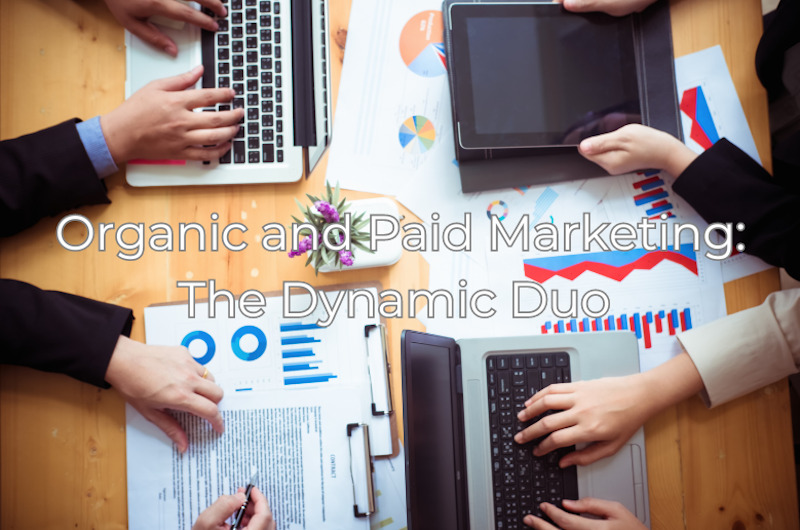In the expansive realm of online visibility, two key players vie for attention: organic and paid marketing. Each operates on a distinct set of principles, yet their synergistic potential can significantly enhance your brand’s short- and long-term presence.
How Does Organic Marketing Work?
Organic marketing is a nuanced dance of non-paid strategies to elevate online visibility. By strategically publishing content across various channels and optimizing it for natural discovery, brands can reach their target audience without delving into advertising expenditures. This method encompasses diverse channels such as search engine optimization (SEO), video marketing on platforms like YouTube, and unpaid social media posts across multiple platforms.
Harnessing the Power of Keywords in Organic Visibility
A crucial aspect of effective organic marketing is meticulously researching keywords that resonate with the target audience. These phrases, the lifeblood of search engine queries, must align seamlessly with users’ searches. For instance, a graphic design tool company might target keywords like “benefits of graphic design tools” or “best graphic design tools.” Identifying and incorporating these relevant keywords ensures that your content doesn’t merely exist but is discoverable by those actively seeking it.
How Does Paid Marketing Work?
In contrast, paid marketing is where brands invest financial resources to secure visibility through advertising channels. Unlike organic marketing, which focuses on brand awareness and traffic, paid marketing is tailored for immediate conversions related to specific campaigns. It sidesteps the waiting game associated with organic approaches, delivering swift results by ensuring your content is promptly thrust into the spotlight.
Exploring Paid Advertising Models: PPC and Sponsored Advertising
Paid advertising, a cornerstone of paid marketing, unfolds across channels such as Google, Instagram, LinkedIn, and YouTube. With a well-funded campaign, your ads can swiftly materialize before your target audience, distinctly marked as “Ad,” “Sponsored,” or “Promoted.” A popular model within this approach is pay-per-click (PPC), where advertisers pay each time a user clicks on their ad. In contrast, sponsored advertising involves collaborating with creators or brands to showcase your content to their established audience, offering a lingering impact even after the advertising budget ceases.
What Are the Key Differences?
Organic and paid marketing, though occasionally converging on the same channels, are fundamentally distinct in their approaches. Organic relies on non-paid strategies, fostering visibility through content optimization, while paid marketing demands financial investment to propel brand messages directly to the target audience. The dichotomy extends to the speed of results, with organic strategies requiring time for sustainable growth, while paid avenues yield faster, sometimes instantaneous, outcomes.
It’s a Balancing Act!
While paid marketing excels in delivering rapid results, organic marketing offers longer-lasting impacts. Organic efforts, once established, can sustain visibility for months or even years, especially with consistent content updates and optimization. On the other hand, paid campaigns are transient; visibility and traffic dwindle the moment funding ceases. The dynamic interplay of these two strategies demands a strategic equilibrium, recognizing the enduring value of organic efforts and the expedited outcomes of paid approaches.
In the intricate tapestry of digital visibility, organic and paid marketing orchestration emerges as a powerful symphony. Understanding and harmonizing these two players can unlock your brand’s full potential, ensuring it resonates across the online landscape in a dynamic and impactful manner.
Striking the Optimal Balance
In the complex digital marketing landscape, where organic and paid strategies intertwine, the key lies in striking the optimal balance. Each strategy brings its unique strengths to the table, and a reasonable integration of both can orchestrate a harmonious symphony that resonates with a broader audience.
Customizing Content
Like an art form, organic marketing involves creating content that resonates naturally with the audience. This process demands time, creativity, and a deep understanding of your target demographic. Conversely, paid marketing operates with surgical precision, delivering tailored messages directly to specific segments. The challenge lies in finding the delicate equilibrium between the authentic storytelling of organic content and the targeted messaging of paid campaigns.
Cost Considerations
While organic strategies often demand ongoing efforts and resources for content creation and optimization, they can offer sustained visibility at a lower cost over time. With its immediate impact, paid marketing comes at a price, with costs associated with ad creation, placements, and click-throughs. Effective digital marketers must weigh the long-term value of organic efforts against the short-term gains achieved through paid initiatives, aligning their strategies with budgetary considerations.
Metrics and Analytics
Measuring success in the dynamic interplay of organic and paid marketing requires a nuanced understanding of metrics and analytics. Organic efforts are often assessed through metrics like organic traffic, keyword rankings, and engagement rates. Paid marketing, conversely, demands a focus on metrics such as click-through rates, conversion rates, and return on ad spend. A comprehensive analytics strategy should synthesize these diverse metrics, providing insights that inform a holistic marketing approach.
Evolving Strategies
The digital landscape is ever-evolving, with algorithms, consumer behavior, and platform dynamics constantly changing. Organic marketing, emphasizing SEO and content optimization, necessitates adaptability to algorithmic changes. Paid marketing demands agility to respond to shifting consumer preferences and stay abreast of emerging advertising trends. Successful marketers navigate this dynamic terrain by continually refining and evolving their strategies, ensuring resilience in the face of digital evolution.
How Do You Maximize Impact?
The true power of digital visibility lies in the integration of organic and paid strategies. While each approach carries its strengths, its synergy can amplify overall impact. A well-optimized organic presence enhances the effectiveness of paid campaigns by fostering brand trust and recognition. Conversely, paid strategies can boost organic growth, creating a symbiotic relationship that maximizes visibility across the digital landscape.
Key Takeaways
Organic and paid strategies play distinctive roles, harmonizing to create a resonant brand presence. The artistry of organic content, meticulously crafted to captivate audiences over time, meets the precision of paid campaigns engineered for immediate impact. Navigating this intricate landscape requires a strategic blend of creativity, data-driven insights, and adaptability.
Digital marketers must embrace the dynamic interplay of organic and paid marketing, recognizing the strengths of each and leveraging their combined potential. In this ever-shifting symphony, success lies not in favoring one strategy over the other but in orchestrating a seamless collaboration that ensures your brand’s enduring resonance in the digital realm.
It’s Time for the Art of Digital Marketing to Work for You
Whether you’re seeking the artful finesse of organic strategies or the precise impact of paid campaigns, Bruce Jones is your go-to expert for navigating the dynamic landscape of digital marketing.
Don’t miss the opportunity to tap the combined power of tailored storytelling and targeted messaging to amplify your brand visibility.
Schedule a meeting with Bruce Jones SEO and embark on a journey toward digital success this year. Your brand deserves nothing less than a strategic blend of creativity, expertise, and a roadmap tailored to your unique goals. Let’s make your digital aspirations a reality—schedule a meeting today!



